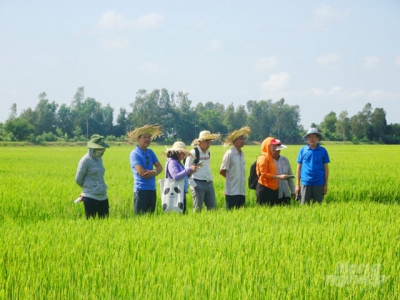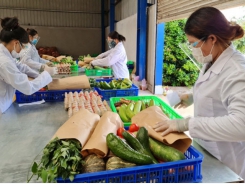Farmers get more profits when applying farming techniques under VnSAT project

Under the Vietnam – Sustainable Agriculture Transformation Project (VnSAT ), farmers are supported to apply water-saving technology and other farming technique to reduce production costs.
From the 2018 - 2020 winter-spring rice crop, the VnSat An Giang project has supported Tan Loi Cooperative in Tinh Bien District, An Giang Province to deploy a pilot model of Internet of Things (IoT) technology application for 3 ha of rice. With the technology, farmers saved money in pumping and watering.
Le Thanh Long, Director of Tan Loi Cooperative said that with more than 25 years working in the industry, he saw that the VnSAT An Giang benefited farmers in many aspects including reduced labour cost, reduced pumping machine rental and effective weed control.
Moreover, rice farming management with IoT helped farmers reduce both fertilizers and pesticides, he said.
Long said that in the past when finding water level in the field was low, farmers brought the machine to pump water into the field. When it was time for fertilizer, they added to water in the field. However, farmers had to regularly go to the fields to check the water level but were still confused about whether the water level was suitable or not.
“Since applying the IoT, farmers can stay at home or go on business trips hundreds of kilometres away, and open their phones to check or activate the pump if needed. From there, it is possible to regulate the water level in the field in the most reasonable way,” he said.
Doan Ngoc Pha, Deputy Director of VnSat An Giang Project Management Board said that IoT application of rice production at Tan Loi Cooperative generated good results. VnSAT An Giang and An Giang Agricultural Extension Center have enlisted funds from the New Rural Program of the province to implement a sub-project on expanding the IoT application at a larger scale.
This sub-project offered training classes for more than 30 farmers and demonstrated 5 models at Vinh Trach Cooperative in Thao Son District in the two rice crops of autumn-winter and winter-spring from 2019 - 2020. As a result, the amount of water for rice decreased on average 30 per cent, rice yield was 0.4 tons/ha higher and profit increased by VND2.3 - 4 million per hectare compared to the conventional alternate wet-dry irrigation.
Sharp reduction of input costs
An Giang is one of eight provinces in the Mekong Delta participating in the rice component of the VnSAT Project with an investment of $16.218 million including $9,647 million of ODA, $2,365 million from the provincial budget and US$4.2 million from private investment.
The VnSAT project in An Giang province is implemented in 5 districts (45 communes) including: Chau Phu (8 communes), Thoai Son (13 communes), Tinh Bien (11 communes), An Phu (7 communes) and Tri Ton (communes). 6 communes) with a total of 26,018 participating households, on an area of 38,602 ha. An Giang province is allocated capital for project implementation with an ODA of USD 9.6 million and reciprocal capital from the provincial state budget of VND 50.8 billion.
In An Giang, the project has been implemented since the autumn-winter crop of 2016 in 45 communes of five districts - Chau Phu, Thoai Son, Tinh Bien, An Phu and Tri Ton. About 26,000 farming households participated in the project.
As of 2020, VnSAT An Giang saw 17,000 ha of rice successfully applied advanced farming solutions. The income for rice growers increased 30 per cent.
Up to now, An Giang province has nearly completed the targets of the project but the project management board continues to promote activities for the extension period to complete the project before June 2022.
Doan Ngoc Pha, Deputy Director of VnSAT An Giang Project Management Board said that under the project,23,000 farmers were transferred advanced farming techniques according to the process “3 decrease 3 increase”, “1 must 5 decrease” through 750 training courses on an area of 35,500 ha.
A hundred demonstrations were carried out to serve the training courses on rice cultivation techniques. Thanks to the project, farmers significantly saved the amount of sown rice, fertilizers, and pesticides, thereby increasing their income from rice production by 22.3 per cent.
In addition, the VnSAT An Giang Project Management Board also enhanced the demonstration points "3 decrease, 3 increase", "1 must 5 decrease" for farmers to witness the actual results of the new technique. An Giang held 100 demonstration sites "3 decrease, 3 increase", "1 must 5 decrease" with nearly 6,000 participants, an increase of 30 sites compared to the plan.
In Can Tho City, many farmers in production cooperation groups and agricultural cooperatives specializing in rice cultivation applauded the increased efficiency and profits when following farming techniques recommended by the VnSAT project.
Nguyen Ngoc Huan, director of Khiet Tam Cooperative in D2 hamlet, Thanh Loi commune, Vinh Thanh district, said that with the support of the VnSAT Project, in 2014, all 40 members of the cooperative started applying the technique of alternating flooded - dry watering on the area of 340 ha. After a few crops, farmers found it easy to do, simple to apply in water regulation, reducing the amount of water supplied to rice by about 50 per cent compared to before.
“Surprisingly, the rice grew well. The rice yield was the same and even higher than before because the rice was very strong and healthy. Consumers like the rice very much,” he said.
The technique of saving water and squeezing water also helped rice plants have fewer pests and diseases, deeper roots, so farmers used fewer fertilizers and pesticides.
Pham Thi Minh Hieu, Director of the Can Tho Cultivation and Plant Protection Sub-Department, the whole city has 31 agricultural cooperatives in Thot Not district and 3 districts of Thoi Lai, Co Do and Vinh Thanh participate in the VnSAT project with a total area of 28,000 ha.
“Water-saving irrigation techniques are widely known, farmers realize the efficiency and benefits because they can reduce the cost of irrigation by about 30 per cent. Meanwhile, in terms of production efficiency, rice yield and quality are still ensured,” she said.
“Rice farming with synchronous technical measures "3 decrease, 3 increase" and "1 must 5 decrease" of the VnSAT Project have contributed to reducing greenhouse gas emissions, protecting the environment and rice farmers themselves,” she said.
Có thể bạn quan tâm
Phần mềm

Phối trộn thức ăn chăn nuôi

Pha dung dịch thủy canh

Định mức cho tôm ăn

Phối trộn phân bón NPK

Xác định tỷ lệ tôm sống

Chuyển đổi đơn vị phân bón

Xác định công suất sục khí

Chuyển đổi đơn vị tôm

Tính diện tích nhà kính

Tính thể tích ao hồ



 To get 1 ton of coffee and pepper,…
To get 1 ton of coffee and pepper,…  Elevating rice and mango value chains in six…
Elevating rice and mango value chains in six…